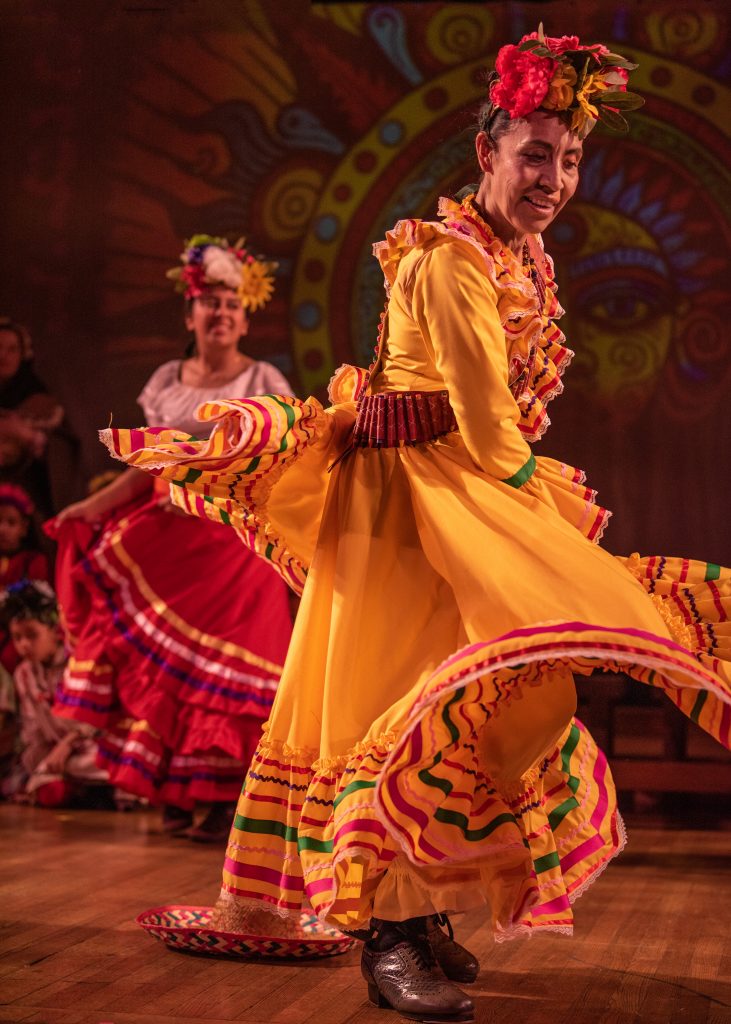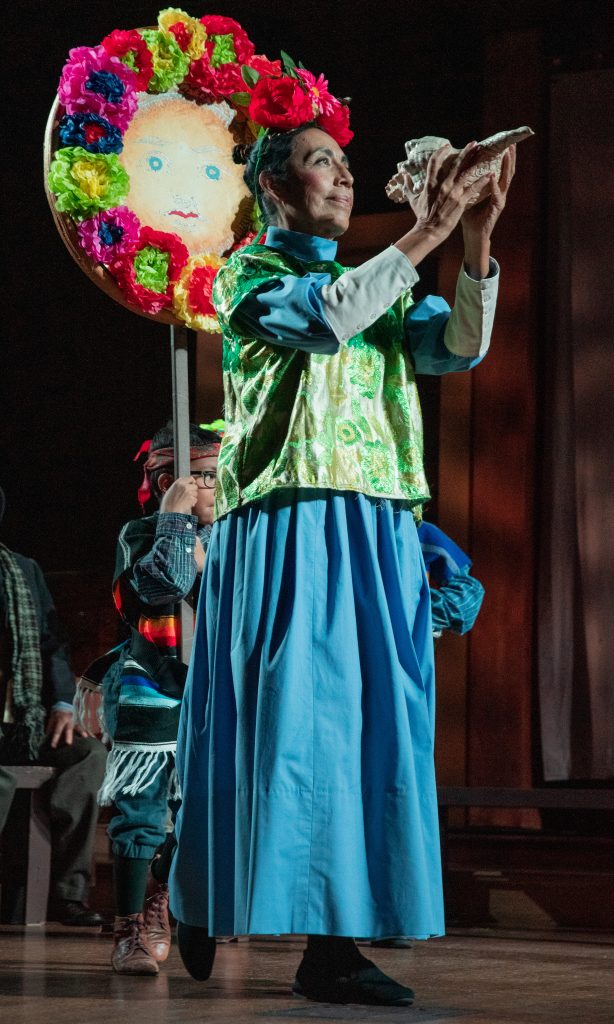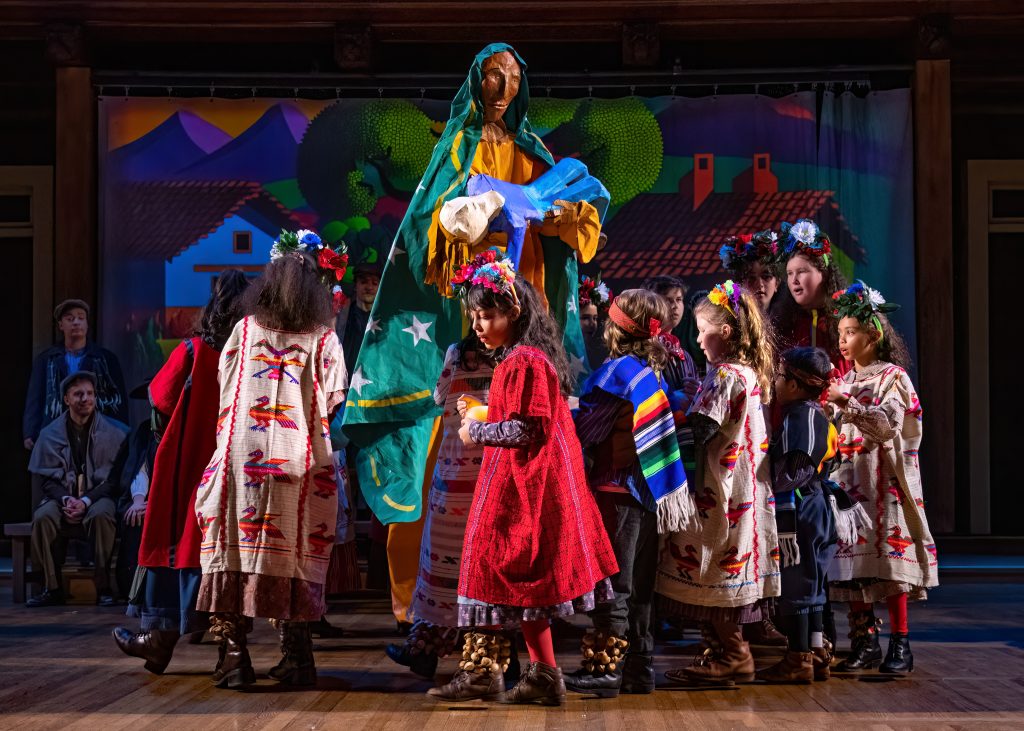Midwinter Revels Performer Spotlight – Rosalba Solis
Blogs
01.12.2023
We are thrilled to announce that Jeffrey Binder will be the next Artistic Director of Revels!
Learn MoreBlogs
01.12.2023
Arts educator, musician, dancer, and tradition bearer Rosalba Solis first worked with Revels in 1994, during the Mesoamerican Christmas Revels. Originally from Guadalajara, Mexico, Rosalba has spent much of her career bringing Latin American music and traditions into Boston Public Schools. She is also the founder of La Piñata, a nearly 30-year-old Latin American cultural organization based in Jamaica Plain, and the recipient of a number of awards and fellowships for her work in education. Rosalba joins us for Midwinter Revels: A Solstice Celebration – Tales from Ellis Island as a choreographer, Mexican tradition-bearer, and performer, playing a member of the Ellis Island medical staff. Revels Digital Communications Manager Sydney Roslin sat down with Rosalba to talk about her career and her work in this year’s Revels production.
Sydney: How did you find out about Revels and get involved to begin with?
Rosalba: Twenty years ago, Paddy Swanson was doing a production about Mesoamerica, and a chorus member in that production knew about my performing arts work in Jamaica Plain, so Paddy reached out to me to participate. At the time I had a company of children dancers, who we put into the show, and I was also in charge of bringing the musicians from Mexico. It was a really cool production! This time, Paddy asked me if I could help with the choreography for some of the Mexican pieces and help with the children’s choir on indigenous pieces that he wanted to put in the show.
He also said that he was adding the story of Los Patricios into the show, and I was puzzled. Not many people know about Los Patricios in Mexico. But when I was researching more about Los Patricios, I found out that it was similar to the life of my grandparents. The San Patricios fought in the 1840s – decades later, all these rebellions were starting to take place to overthrow the Mexican government. There were rebels from different towns getting together to fight the government, and my grandfather was one of those rebels. He met my grandmother while he was traveling from town to town and they fell in love. All the women of these men needed to learn how to take care of themselves while they were in the encampment – they cooked, washed, and mended everything for these men. When they were alone, these women had to learn how to use the carabinas, the long shooting guns, and they carried magazines of bullets with them. That’s why I’m wearing one onstage. They would carry rifles with them while they were washing, and cooking – they could be ambushed by the government at any time, so the women were ready to shoot. Eventually, my grandmother got pregnant, and when she gave birth to my mother, she went back to her family, which was in Guadalajara. Whenever my grandfather was passing by with the rebels, he would stop in the house and visit, until he got shot in the revolution. Later on, somebody from the government of Mexico gave my grandmother the Mexican flag as a thank-you for his service to the revolution.
Anyway, as I was doing all this research into Los Patricios, I realized I had to be there for my grandma and my grandfather. It became a little more personal. Originally, I thought I would just be doing the choreography, I didn’t know much about being on the stage or anything, but then I ended up onstage and became an actress!

S: You’ve run La Piñata in Jamaica Plain for over thirty years. Can you tell us about that?
R: Yes. La Piñata no longer has children – my La Piñata children are teenagers and the teenagers are now adults. So our work has switched a little, but the mission is still the same. We bring Latin American culture to diversify the places we go. We go to the universities and high schools to give talks, we put on presentations for festivals for Day of the Dead, really anything that organizations want to do. September to October is very big for Hispanic Month, so we get very busy. Sometimes I am the one that goes to do these talks and conferences and workshops, and sometimes I need to involve some of those teenagers and some of those adults. Actually, one of the adults is very involved right now with Revels, she made all the beautiful flower crowns that you saw on the kids on stage.
S: Can you talk a little bit about your work in the Boston Public Schools?
R: I retired a few years ago as a performing arts teacher, and now when I come, I come on contracts to bring Latin American culture into the schools. I usually like to work with bilingual schools because not as many people work with bilingual schools – those principals, they know me.
This year, I started training music teachers in Boston Public Schools, so I’m busier than ever. I work with music teachers to make sure they’re using the curriculum and the materials they’re supposed to be using, and train them in how to teach music. Most of these teachers are first-year teachers, so they don’t have much practice besides their student teaching. But when they give you a whole school to work with, it’s just very different, and you have to be on top of everything. I wish I had a teacher like that when I was starting to help me or guide me through that.

S: How did you find your way into music and into teaching?
R: When I was a teenager I started at a conservatory of music in Guadalajara, and my main instrument was the saxophone. But the conservatory only taught classical music. So after four years there, I became an instructor of music, so I could go to other places and teach music, but it was hard to find places to play saxophone. There is no saxophone in symphony orchestras – I could be in marching bands, or play up and down the beaches, but that’s not what I wanted to do.
Then musicians from the Philharmonic Orchestra in Texas came to visit the conservatory where I was taking my lessons. They played me recordings of Charlie Parker and John Coltraine, who I’d never heard before, and they said “You should be playing that, not classical music.” Somebody even handed me a clip of newspaper about the Berklee College of Music in Boston, Massachusetts. So I saved my money for one year, grabbed my saxophone, my music, and some changes of clothes, and I just came to Boston. It took five days on a bus from Texas all the way to Massachusetts.
The hardest part of that trip was that every time the bus moved to a different state, the accent of the English changed, and in each state I was understanding less and less and less and less… I didn’t understand anything.
But I ended up coming to Berklee, and I graduated from Berklee College of Music. By the time I was graduating, I already had a job offer at a Montessori school teaching music and movement. Before you know it, I started teaching in private schools, and they like cultural immersions, so I started learning different ways to teach – and music is the best way to bring everything together. But it was not enough for me. I wanted to add some of the dancing, and some of the performance aspects, so I started La Piñata, and I hired theatre teachers and dance teachers. I started learning a lot of other things besides what I was teaching, which opened me to new ways to impact my own students.
At that time, I applied to Boston Public Schools, and they asked me for my education certificate. I didn’t have an education certificate – I had graduated from Berklee as a musician. So one whole summer, I sent my kids away with my husband to Mexico and I stayed behind. I went to Wheelock College and I took all of the courses I need to finish up for the education certificate, and because it was so close to a Masters, I decided to enroll in the Masters program in performing arts education at night. That further cemented the need of theatre, the need of visual arts, of dancing to weave into the music that I already was doing. I also learned a lot from Paddy during the Mesoamerican show – I watched everything he was doing, how he was teaching, how he was doing the staging. He impacted a lot of how I taught in Boston Public Schools.
The shows I put in Boston Public Schools for my school were whole productions from beginning to end. And I was able to involve students from kindergarten through eighth grade through music, dance, and theatre. People would start sending me student teachers so I could help them get their accreditation. I had student teachers that came from Emerson College, which I loved, because whenever I took on students, they would give me free credits to take classes at Emerson. I learned so much! Acting, the use of the stage, playwriting, and I got to see how these other teachers saw it all, not from the lens of the musician, but from the theatre perspective. All of that impacted me, the way that I taught. Now I can go to any place, and if I don’t have anything, that’s fine – I can do something with 100 kids on the stage. I don’t need to have a classroom, I can be in a park and I can just teach. I think that’s something very special.

S: How did you work with Elijah on the music or with Paddy on the text for this show? I know that you choreographed the dance, but what was your involvement in the script and music writing process?
R: For this production, it was really nice to involve the Mayan song “Xtoles.” The song translates to “Hurry up, children, hurry up. The sun is about to leave.” It is a very old piece, more than 300 years old. In the staging, we bring the sun alive through the conch shell sounds and the children add in their beautiful voices. Elijah wrote a beautiful arrangement for the grownups in four voices, and they sounded really good. We also worked on Xochipitzahuatl, which is the piece with the big, big Virgin of Guadalupe puppet. The Virgin of Guadalupe embodies Tonantzin, Mother Earth. It’s a beautiful representation of Mexico, and we all honor her. For us indigenous people, this virgin originally represented Tonantzin. The original symbol of Tonantzin is a big, humongous, engraved rock, and it’s squatting, giving birth, naked. It’s just beautiful. But a little over 500 years ago, the people that invaded the rest of the continent didn’t agree with the spirits that were sacred for us and the representations and the beliefs we had at the time. In turn, we got the Virgin Guadalupe, and now she’s all covered.
Anyway, we worked a lot on that piece. I thought that it would be very appropriate for Revel’s show, and Paddy just went crazy for it, because when I showed up at a Saturday rehearsal, there was just a humongous puppet. He kept on saying “Oh, there’s going to be a little puppet crossing by the stage” during rehearsals. Well, it’s not just a little puppet! It’s big, and it’s heavy. Our puppet designer, Sara Peattie, made a fantastic puppet.
S: What do you want audiences to walk away with after seeing this show?
R: I would like them to be inspired to go further and find out a little bit more about who Los Patricios were. These Irish soldiers came to give a hand to the rebels. I would like to know the names of these men… who the Irish guy was that went and said “We need to help the Mexicans.” I guess that these people really like justice, because they were fighting for injustice.
So as to your question, people should learn a little bit more and do a little more research of what they’re going to see in the show. I needed to research a little bit more, and I’m from Mexico! So audiences should enjoy the show, and then go deeper.
All photos taken by Paul Buckley.
You can watch Rosalba’s performance now in Midwinter Revels: A Solstice Celebration – Tales from Ellis Island through our Virtual Encore! Due to popular demand, the viewing period for our Video On Demand option has been EXTENDED through January 15. Bring the magic of Revels to your home and watch the entire show, filmed live during a performance in Sanders Theatre, with unlimited streaming during the viewing period. Learn more and purchase your Virtual Event Pass at revels.org/midwinter.